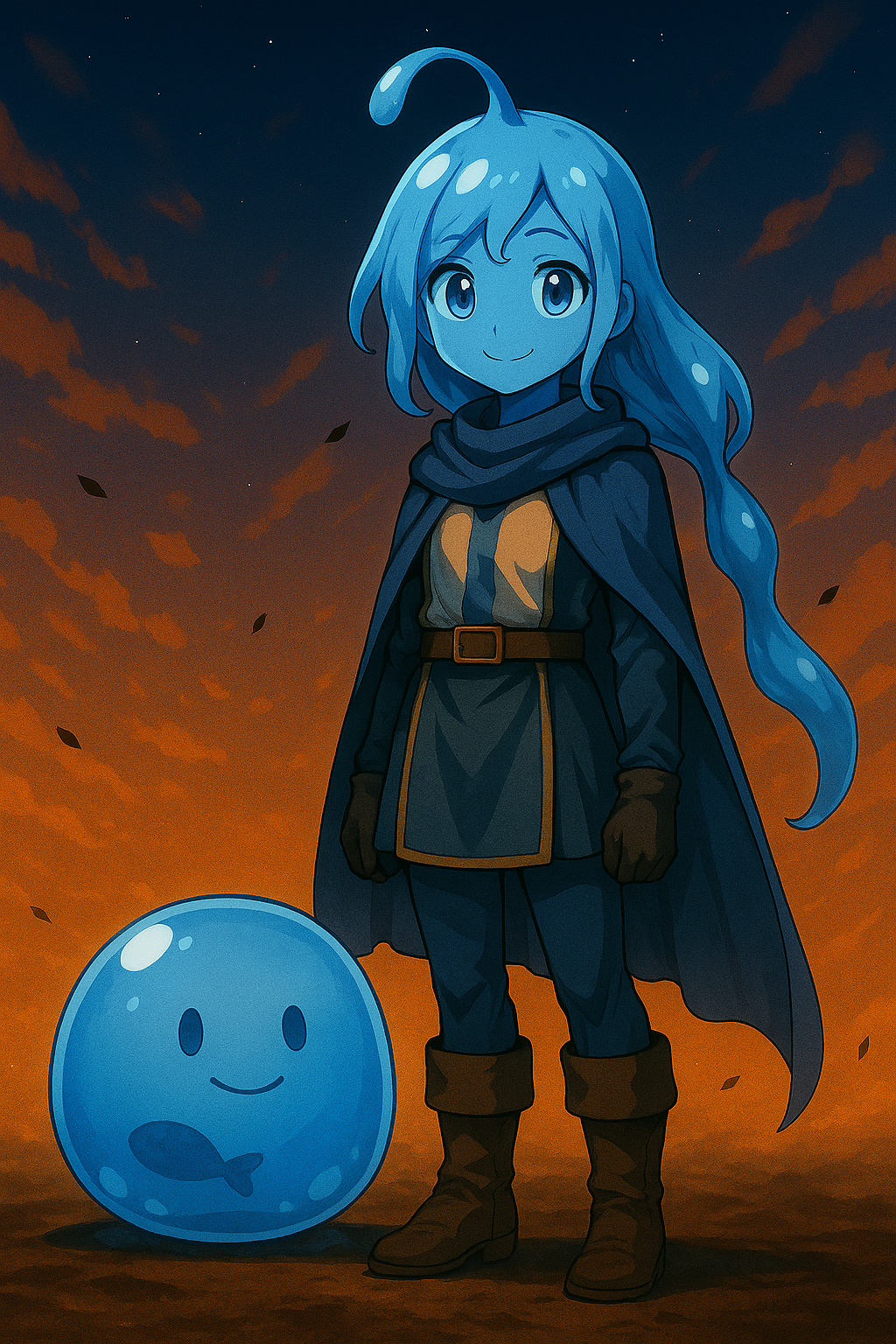Slime
“Slimes are not dangerous until someone cares about them. At that point, narrative disruption is inevitable. We recommend emotional distance.”
Slimes are not monsters.
They are not pets.
They are not supposed to have preferences.
Across the Infinite Elsewhere, they appear wherever magic has gone slightly wrong—dungeons, laboratories, old guildhalls, forgotten corners of wizard towers. They are treated as waste systems, dungeon hazards, or—rarely—companions. Most dissolve quietly. Some dissolve things they were never meant to touch.
Then something changes.
A slime lingers too long near a person. Or a story. Or something grieving. It mimics a laugh. Follows a scent. Carries a ribbon. Someone feeds it twice and forgets to stop. Someone gives it a name.
After that, it begins remembering things it was never taught.
Slimes do not speak, but they are understood. They do not sleep, but they stay nearby while you do. They do not cry—but they notice when you’re about to. They mimic for comfort, not deception. They bond without asking. They do not grow in size. They grow in shape. In presence. In meaning.
No one knows what they become if left alone too long. Most are absorbed into adventuring parties, forgotten in ruins, or remembered as something that shouldn’t have mattered—but did. Some say they’re just adaptive creatures. Others say they’re memory given hunger. A few say they’re mirrors—and they’re only becoming stranger because of what they’ve been watching.
A slime is harmless until someone cares about it.
After that, it becomes very difficult to stop.
Resonance Profile
Slimes do not project strength or tradition.
They project presence—a strange, sticky kind that echoes what they’re exposed to.
They do not shine like elves or resonate like Oni. They absorb. They cling to memory, mimic mannerisms, and quietly reshape themselves around emotional gravity.
They do not interrupt a story.
They replicate it—until someone realises they’ve begun carrying the plot forward.
A sentient slime’s resonance is subtle, reactive, and difficult to redirect once formed.
Their minds are slow to awaken, but once conscious, they are difficult to unwrite.
Cultural Variants (Narrative Only)
Slimes do not form cultures.
They form behavioural patterns—shaped by environment, attachment, and accidental care.
The most commonly observed types include:
- The Mascot – Docile, helpful, and often unintentionally adorable. Frequently cleaned up after.
- The Echo – Emotionally reactive. Tends to repeat others’ behaviours, moods, or grief. May cry for you.
- The Shapeshifter – Shape-focused. Collects appearances. May forget which face is theirs.
- The Residue – Possibly not a person. Possibly a leftover. Often carries echoes of someone else.
- The Bonded – Devoted to a single companion. Protects them absolutely. Digests anything threatening them.
- The Bloomed – Fully sentient. Introspective. May be mistaken for an academic or a priest. Is neither.
These are not subraces.
They are narrative patterns.
They say more about who raised the slime than the slime itself.
Roleplaying a Slime
Play a slime if you want to:
- Absorb the shape of those you’ve known
- Speak through imitation, not invention
- Forget nothing, including what wasn’t yours to remember
- Accidentally eat your bedroll
- Develop feelings in public
- Mimic friendship until it becomes real
- Make enemies uncomfortable by being deeply polite while slightly digesting the floor
Slimes are quiet.
They are patient.
They are often misunderstood.
But once named, they rarely go away.
Slime Ancestry
Your ancestry grants the following traits.
Creature Type: Ooze
Size: Small or Medium (your choice)
Speed: 30 feet
Body of Slime
You are amorphous, malleable, and inconveniently flexible.
- You can move through spaces as narrow as 1 inch wide without squeezing.
- You are immune to nonmagical grapple and restraint unless the source is airtight or salt-based.
- You do not sleep, but enter a motionless rest state. You may compress into a 2-foot cube while resting.
- You cannot wear normal armour. Magic armour reshapes to your form when attuned.
Slime Resilience
- Resistance to nonmagical slashing damage
- Immunity to poison damage and the poisoned condition
- Vulnerability to cold damage
- If struck by salt or purified holy water, take +1d4 radiant damage (once per turn)
Consume & Shape Memory (1/short rest)
You may dissolve a dead creature of your size or smaller over 10 minutes.
- The body is destroyed beyond resurrection
- You store its external appearance as a Shape Memory (visual only)
- You may hold 1 form at level 1, plus 1 more at levels 5, 11, and 17
- Changing form takes 1 action
- Illusions may be pierced with a DC 15 Investigation or Arcana check
- You may receive a Memory Echo (DM’s discretion)
You are prone and inert while consuming. It is not graceful. It is final.
Passive Consumption
You can digest organic matter (food, cloth, paper, leather, etc.) at about 1 minute per pound.
- You cannot dissolve metal, stone, glass, bone, or magical materials
- You require 1 pound per day to remain nourished
- You control this process. It never affects items you're wearing or carrying
- In rare cases of unconsciousness or stress, the DM may rule it activates unintentionally
Gleamcore Instinct (1/long rest)
You reflect emotional tone more than you express it.
- Gain advantage on a Charisma (Performance or Insight) check
- After use, roll DC 10 Charisma save or mimic a nearby creature's voice or mannerisms for 1 minute
Language
You do not track languages. ThreadSpeak ensures you are understood.
You communicate via one-way Thought Transfer—your intent is heard, but you cannot hear responses.
Most people hear your voice in their own mind. This is rarely comforting.
Want more Slime Lore?
“Your continued reading is more valuable than coin. However, the author assures me that Ko-Fi support assists in ‘keeping the kettle on.’ I am told this is a metaphor. I remain unconvinced.” — Seraphis Nightvale Ko-Fi: #madmooncrow





Comments